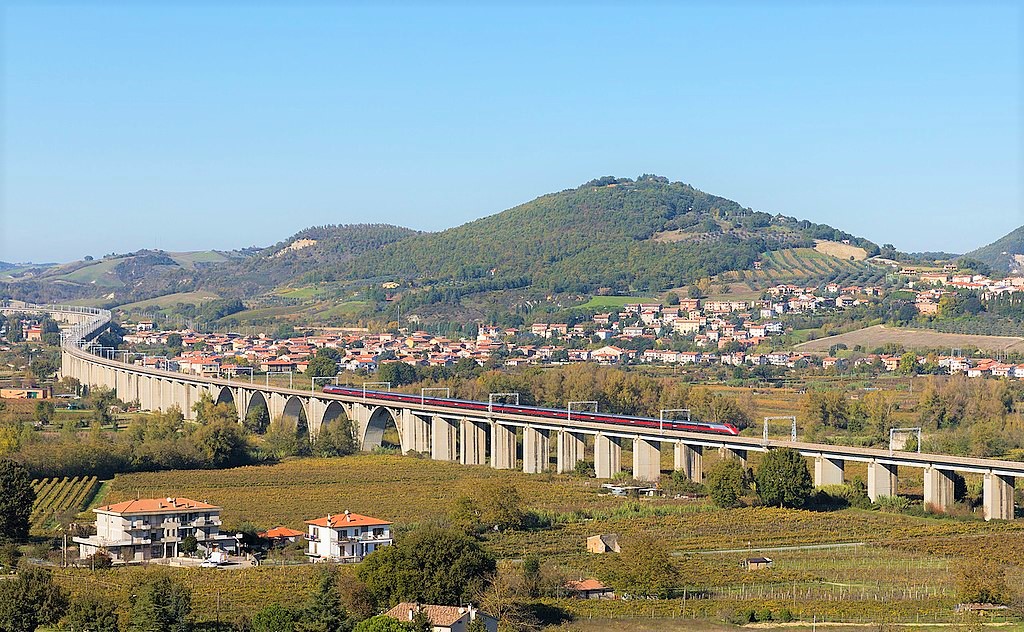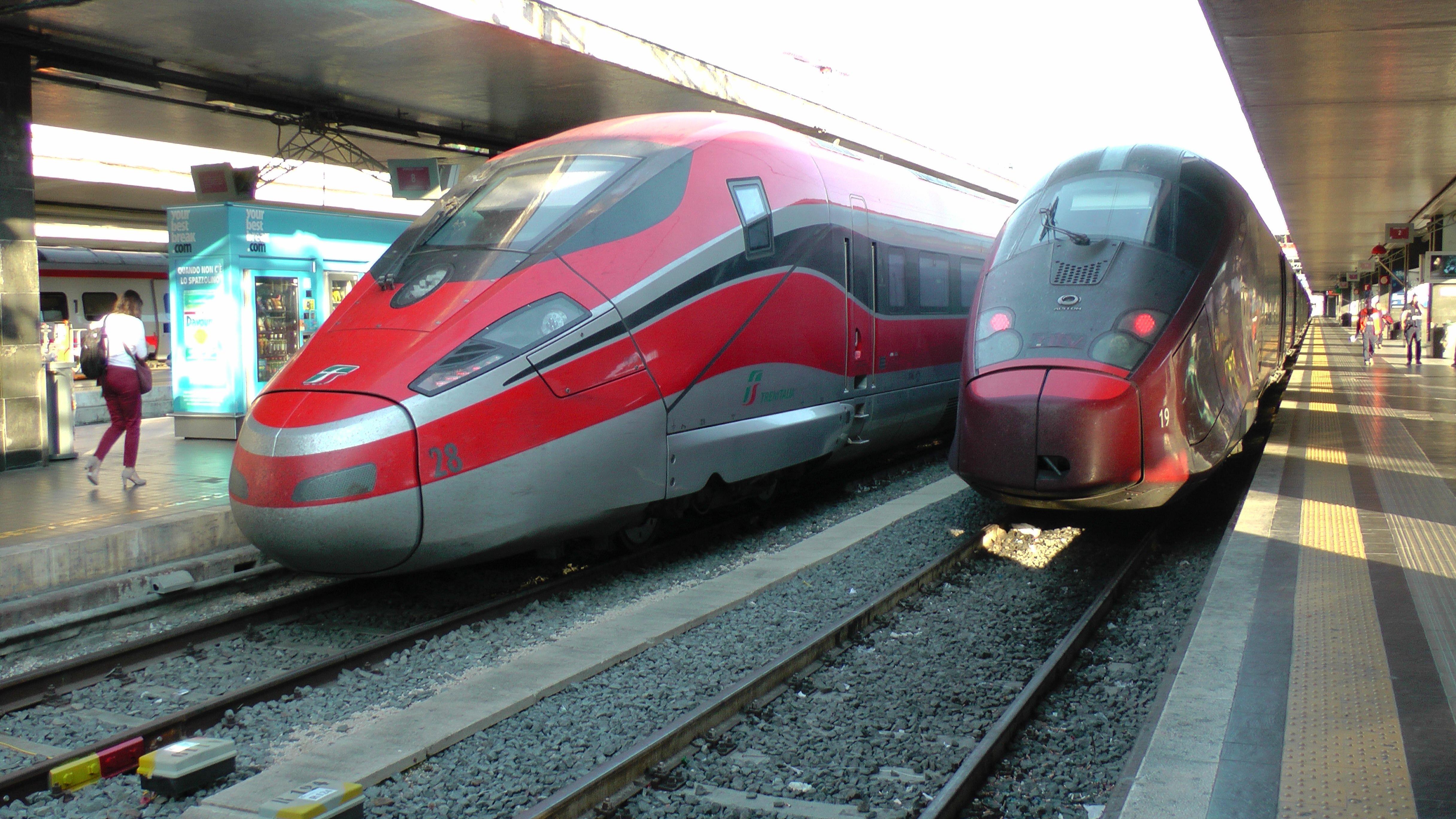04/06/2022 – By Frédéric de Kemmeter – Railway signalling and freelance copywriter – Suscribe my blog
(Version en français)
🟧 Back to homepage 🟧 See our brief news
2022 is definitely an anniversary year for high-speed rail in Europe. At the end of May 1992, Italy also joined the little club of high-speed train operators. Althought Italy had in been partially operating a new high-speed line since 1977, we retain the year 1992 with a complete new line and the operation of a new train.
A favourable geography
The Italian urban network includes a good handful of cities with more than 1 million inhabitants (Rome, Milan, Naples), complemented by an impressive group of 160 cities with 30 to 600,000 inhabitants (Genoa, Palermo). Often active and well-equipped, even hosting some higher functions (universities, head offices such as that of Benetton in Treviso), these medium-sized cities play a significant role in the framework of the territory, especially in central Italy.
The importance of some of these cities (Milan, the financial centre of the country, Turin, the industrial centre) has made it possible to avoid the exaggerated centralism found in Great Britain, France and Spain, countries where everything leads back to their respective capitals.
All this gives us a relatively well meshed rail network that is reminiscent of the geographical structure of Germany, with the notable exception of the south of Italy.
There is little doubt that the Milan-Bologna-Florence-Rome-Naples axis constitutes the backbone of the peninsula, on which the majority of passenger transport flows can be found.
Yesterday and today
In the past, those who used the Italian railway network did not come back with fond memories of the network, the stations and the trains in operation. It was exotic and often dusty. The grandparents of today’s Generation Z have told so many stories about their railway memories that it must have deterred young Italians to take the train…
This is something that some people within Ferrovie dello Stato (FS – State railways), had picked up on. To turn this image around, something disruptive was needed!
The FS studied the possibility of increasing speeds mainly on the Milan-Naples route and also on the Turin-Milan-Verona-Venice route.
In the 1970s, the Fiat Ferroviaria division brought out a series of tilting trains called ‘Pendolino‘. They were not really successful on the winding Italian classic lines and, despite hopes from marketing services, did not produce a large-scale modal shift.
At that time, only Japan had already put the principle of the new line with dedicated trains into practice since 1964, demonstrating the feasibility and the conditions necessary to improve the long-distance rail service.
The Italian choice was to build new lines that would also accept conventional trains, including freight trains. The Italians were thus closer to the German than to the French or Japanese concept.

The new Firenze-Roma ‘direttissima‘ line, which literally means « the most direct Florence-Rome railway », was the first new line project in Europe. On 25 June 1970, the foundation stone of this ‘direttissima‘ was laid near the river Paglia, where the longest viaduct of the entire line was to be built. Various vicissitudes, both political and economic, have greatly lengthened the construction period and sometimes cast doubt on the choices made by the Italian railways.
The ‘direttissima‘ can, however, be considered the first high-speed line to be opened in Europe when the first half of it was put into service in 1977. The second half was completed in 1992, a total of 22 years of construction for 314 kilometres.
This new high-speed line reduced the journey time from Rome to Florence to one hour and 20 minutes, compared with just under three hours at the best period of the Trans Europ Express in the 1980s.
But its opening in the early 1990s also coincided with the arrival of a new train never before seen in Italy, which is why 1992 is remembered as the real starting point for Italian high speed. This brings us to the 30-year anniversary in this year 2022.

In the first half of the 1980s, the design, construction and testing of prototypes were carried out, to finally arrive at a train called ETR500, whose nose was designed by the famous Pininfarina design studio. These first Italian high-speed trains were put into service in 30 units between 1992 and 1996, and a further 30 between 2005 and 2007.
Interestingly, the layout of the ETR500 is the same as that of the French TGV and the German ICE (generation 1): a train of cars framed by two power cars. However, the Italians did not opt for the articulated train set as with Alstom or Talgo.
In November 2009, Trenitalia launched a tender for the supply of 50 new high-speed train models to succeed the ETR500. In June 2010, Bombardier joined forces with AnsaldoBreda to bid for a train that was fully compliant with European TSIs. The duo was declared the winner in August 2010 with the choice of the Bombardier’s Zefiro V300 for €30.8 million per train set, slightly below Alstom, which had bid €35 million each.
Another detail: the Zefiro V300 – also known as the Frecciarossa 1000 – is a self-propelled train set with engines distributed over several bogies, thus freeing up two cars and as many additional seats for sale. The Italians then offered four classes on board, which was never seen in Europe…
The Frecciarossa 1000 would have been the first high-speed train in the world to be awarded the environmental impact certificate (EPD) because it manages to contain 28 grams of CO2 emissions per passenger kilometre. It would be the quietest and least vibrating train produced in Europe, according the technical sheet.
And so was built what is now Trenitalia’s trademark: the ‘Frecciarossa‘. This is also the train that currently runs from Milan to Lyon and Paris, and will soon be running on Spanish tracks under the name iryo (with ILSA).
Nowadays, Hitachi Rail Europe has taken over the activities of both AnsaldoBreda and Bombardier, and has made it ‘its’ high-speed train. The drawings revealed for the HS2 contract in Britain show trains that look an awful lot like the Frecciarossa…

The railway that the grandparents of Generation Z knew is today quite different, at least on the main line services.
Since 1985 Ferrovie dello Stato (FS) has undergone profound restructuring processe that have imposed an economic and financial recovery of the state company, including the transformation of the former FS into a joint stock company from 1992 (a public law corporation), but also by adopting the vertical separation of infrastructure (RFI) and services in 1998.
The former « FS » is now the « FS group », which is one of RFI’s clients. Its passenger division, both regional and mainline, is called ‘Trenitalia’. The mainline train service distinguishes four « brands »: Frecciarossa, Frecciargento and Frecciabianca, and also Intercity Notte, the night trains. The dusty stations have been completey relifted. However, serious efforts are still needed on the regional train, but this work is underway.
The Italian high-speed network has only 1,248 kilometres of lines, of which more than 300 are still under construction, putting the country in 7th place worldwide. The theoretical capacity of the high-speed network is 12 trains per hour per track, but the hourly capacity is limited to 11 trains per hour per track.

A second player
In 2012 – wanother anniversary date – a competitor came along to shake up the high-speed segment even more. NTV-Italo arrived on the Italian routes with very large investments (and the support of a « real regulator », which did not exist before 2014…).
Inspired by the structure of low-cost airlines, Italo brought a new way of dealing with fixed costs and digitised every process as much as possible, while many tasks were outsourced, such as rolling stock maintenance, catering and security.

By 2019, NTV-Italo, with its fleet of AGVs and EVOs, covered the entire national high-speed network, connecting a total of 25 Italian cities and 30 stations with 116 daily services.
Initially seen as a threat, rail competition between two players is no longer debated today. By contrary, it seems to have been a stimulus for Trenitalia to improve and become more customer-oriented. Generation Z has returned to the stations and deserted the short flights. Italo has a 30% market share on the Milan-Rome route, where Trenitalia has seen a rebound in traffic from the stagnation before 2012.
Traffic
Before the pandemic, Trenitalia operated 52 Frecciarossa return trips on the Milan-Rome route with an overall capacity of 27,000 seats per direction, while NTV-Italo offered 30 return trips and 13,800 seats per direction. In other words, Italians had a total of 82 return trips and 81,600 seats on a working day. The market share of rail on the Milan-Rome route was 75%.

The pandemic had to break this beautiful momentum forever. At the worst of 2020, there were 12 Rome-Milan round trips by Frecciarossa and only 3 by NTV-Italo trains, with every second seat occupied.
Traffic has been slowly rebuilt towards 2021 but it is no longer at the level of 2019. Around 37 Frecciarossa flights are scheduled on the Milan-Rome route, to which must be added the 32 round trips of NTV-Italo, giving us a total of 69 routes between the two leading cities of the country, that means a supply of around 60,000 seats. Frecciarossa connections between Venice and Rome now reach 16 round trips per day, almost one per hour.
Italian high-speed rail is now mature. With two operators and competition increasing traffic, Italy was until recently a unique case in Europe and in the world, before Spain showed another model, more regulated, but just as interesting. This allows the FS group, via Trenitalia, to offer its services abroad and to look for other growth drivers. Happy birthday to you…

04/06/2022 – By Frédéric de Kemmeter – Railway signalling
Suscribe my blog


Vous devez être connecté pour poster un commentaire.